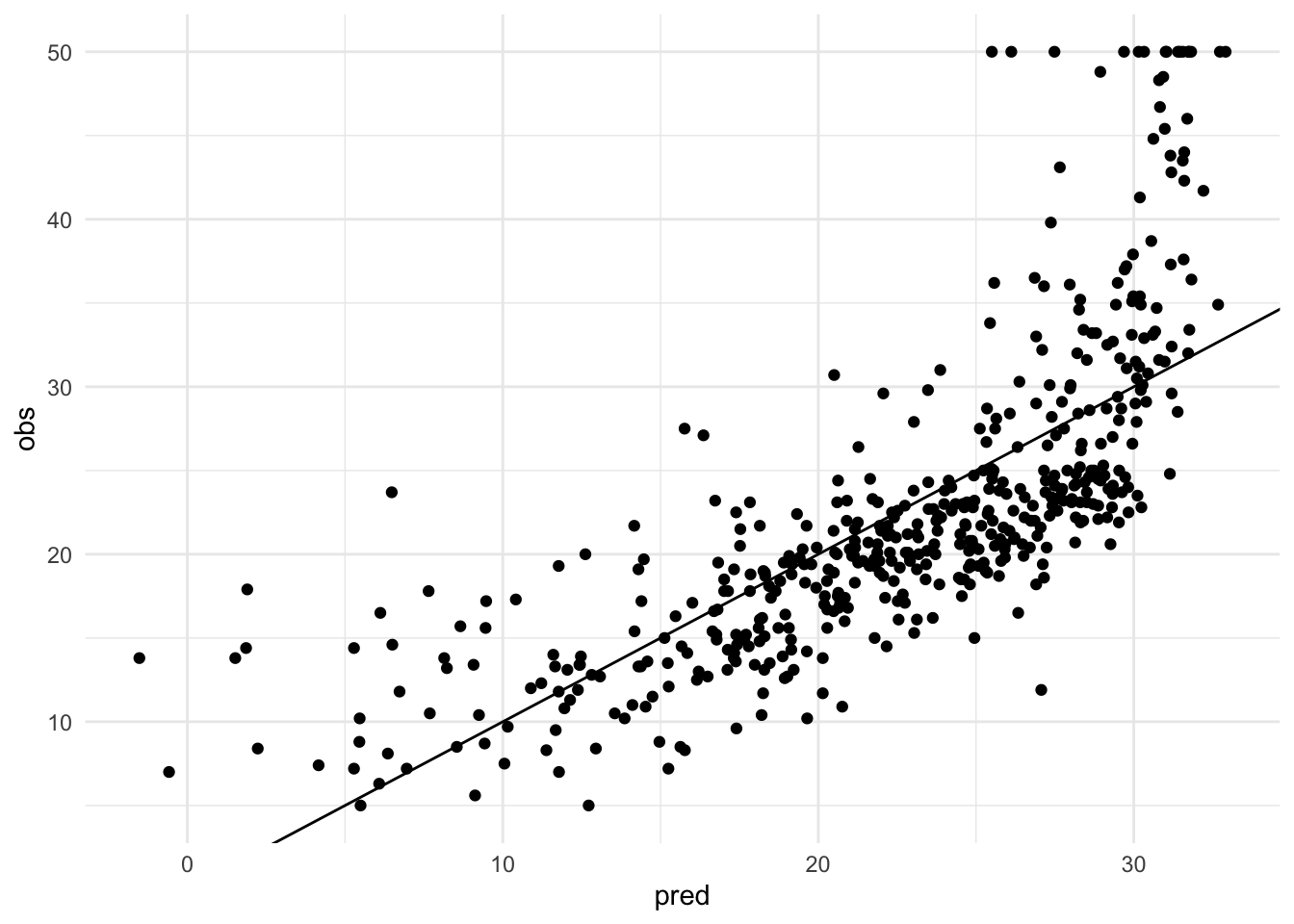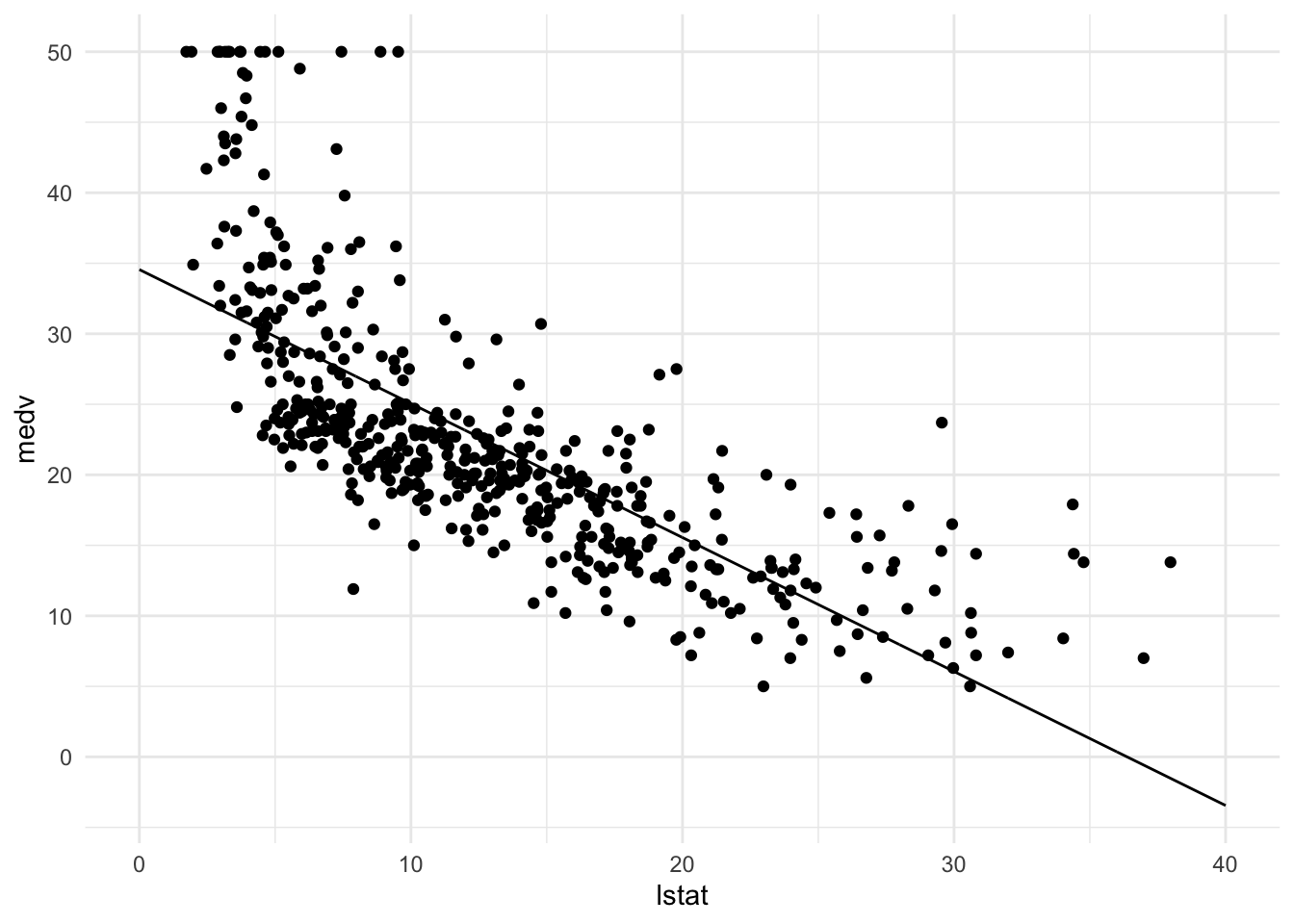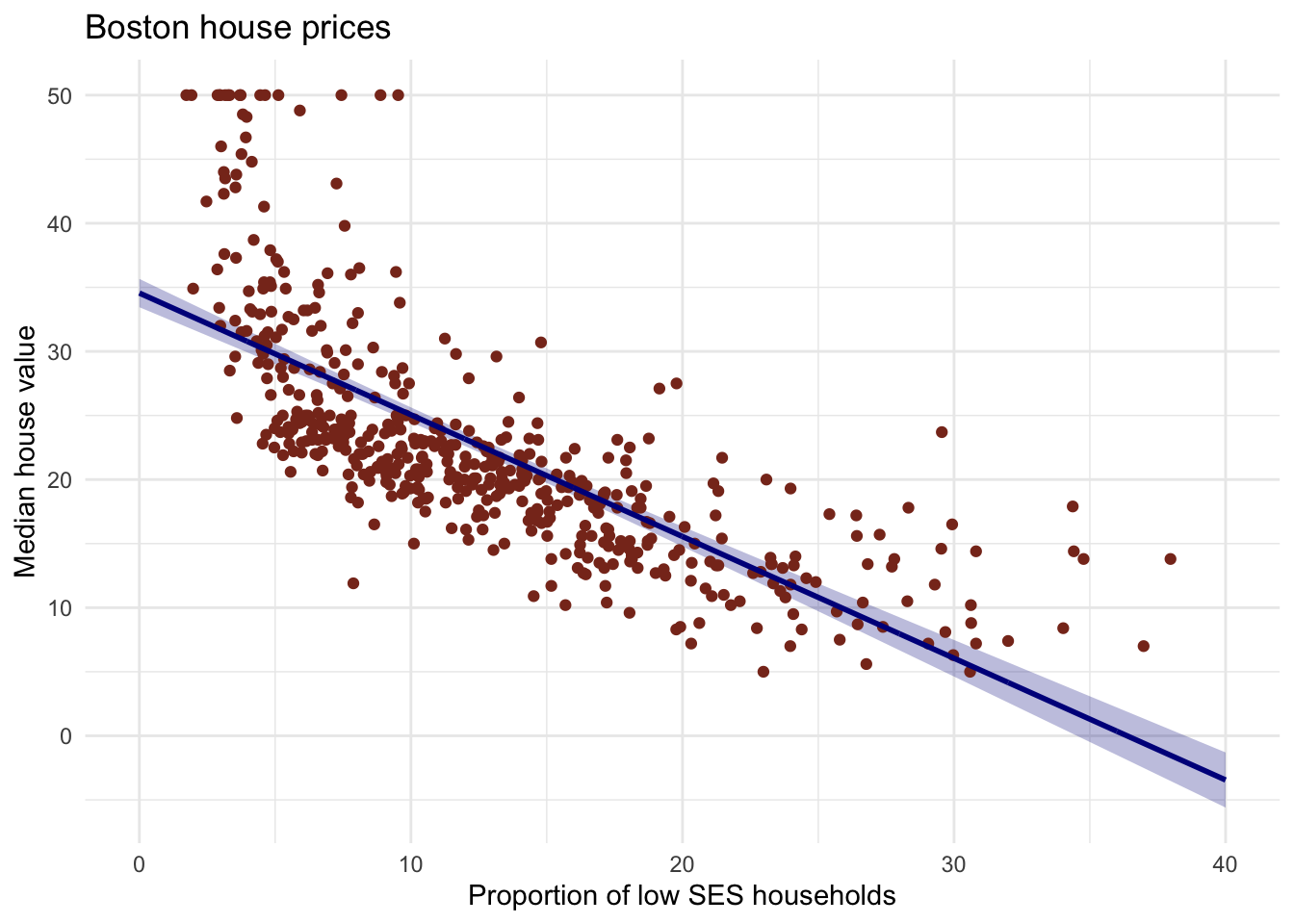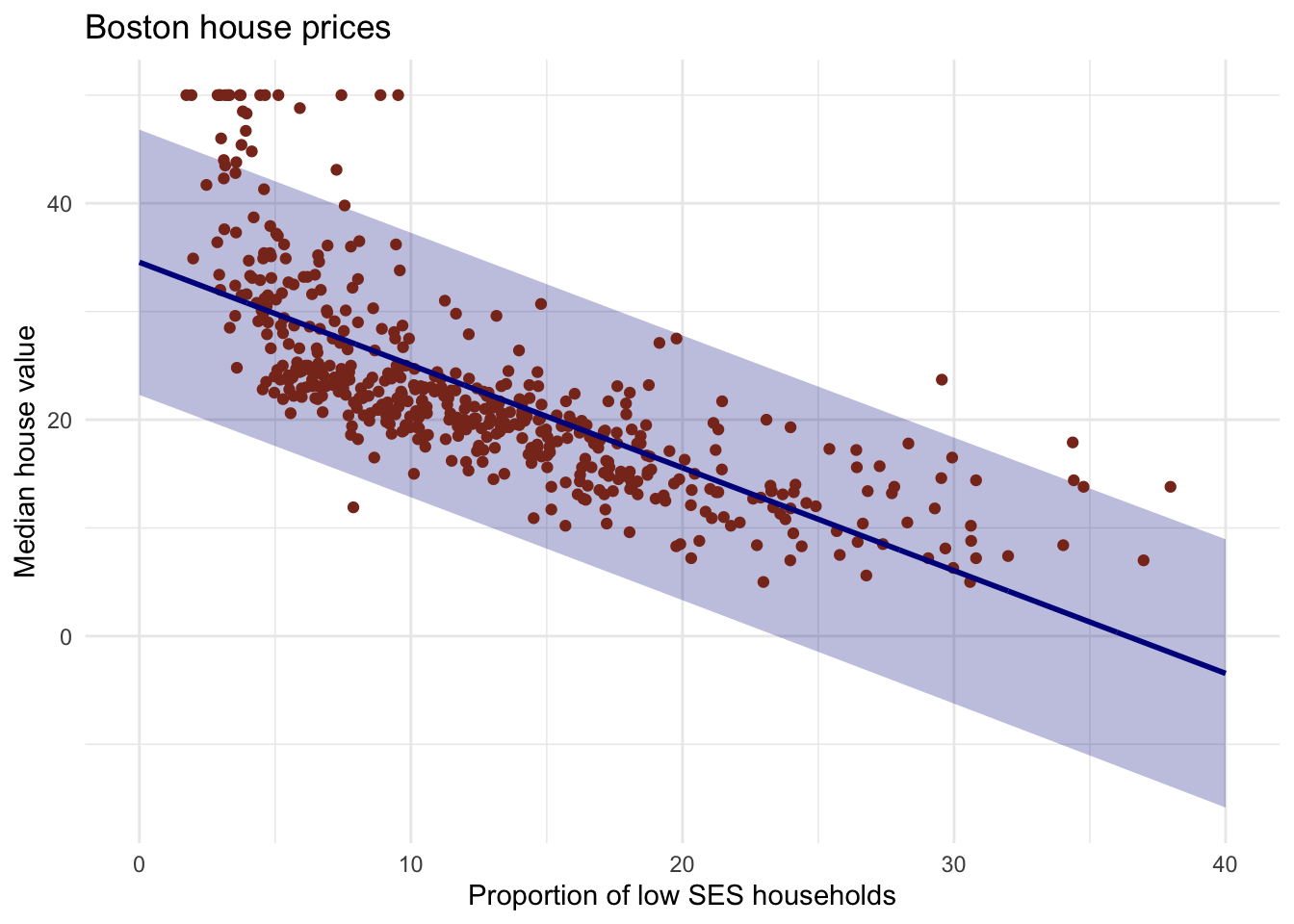3.4 Linear Regression - CI, MSE, Split, Cross Validation
#加载必备包
library(ISLR)
library(MASS)
library(tidyverse)
Regression in R
#linearmodel #linearregression #slope #coef
#创建一个线性模型
some_formula <- outcome ~ predictor_1 + predictor_2
#例子
#medv = housing value, lstat = socio-economic status
lm_ses <- lm(formula = medv ~ lstat, data = Boston)
#查看formula的 intercept and slope
coef(lm_ses)
#解读slope结果
## (Intercept) lstat
## 34.5538409 -0.9500494
# for each point increase in lstat, the median housing value drops by 0.95
#得到公式medvi=34.55−0.95∗lstati+ϵi,知道新的lstat可以预测medv
#保存预测的y值
y_pred <- predict(lm_ses)
#观察散点和线性模型的fit程度
tibble(pred = y_pred,
obs = Boston$medv) %>% #$代表vector
ggplot(aes(x = pred, y = obs)) +
geom_point() +
theme_minimal() +
geom_abline(slope = 1) #已知理想的线性模型

#生成用于预测的lstat数据
pred_dat <- tibble(lstat = seq(0, 40, length.out = 1000))
#使用新生成的lstat数据放进lm_ses模型预测medv
y_pred_new <- predict(lm_ses, newdata = pred_dat)
Plotting lm() in ggplot
#scatterplot
#把y_pred_new添加到pred_dat dataframe里的medv的方法一
pred_dat$medv <- y_pred_new
#方法二
pred_dat <- pred_dat %>% mutate(medv = y_pred_new)
#带有线性模型的散点图(未知理想的线性模型是什么样的,需要计算)
p_scatter <-
Boston %>% # dataset名称
ggplot(aes(x = lstat, y = medv)) +
geom_point() +
theme_minimal() +
p_scatter + geom_line(data = pred_dat)
p_scatter

#confidenceintervals #ci
#查看confidence interval
y_pred_95 <- predict(lm_ses, newdata = pred_dat, interval = "confidence")
head(y_pred_95)
# 得到matrix with an estimate and a lower and an upper confidence interval
## fit lwr upr
## 1 34.55384 33.44846 35.65922
## 2 34.51580 33.41307 35.61853
## 3 34.47776 33.37768 35.57784
## 4 34.43972 33.34229 35.53715
## 5 34.40168 33.30690 35.49646
## 6 34.36364 33.27150 35.45578
#根据matrix创建dataframe
gg_pred <- tibble(
lstat = pred_dat$lstat,
medv = y_pred_95[, 1],
lower = y_pred_95[, 2],
upper = y_pred_95[, 3]
)
gg_pred
#ribbon #geomribbon
#plot confidence intervals
Boston %>%
ggplot(aes(x = lstat, y = medv)) +
geom_ribbon(aes(ymin = lower, ymax = upper), data = gg_pred, fill = "#00008b44") +
geom_point(colour = "#883321") +
geom_line(data = pred_dat, colour = "#00008b", size = 1) +
theme_minimal() +
labs(x = "Proportion of low SES households",
y = "Median house value",
title = "Boston house prices")
#解释:The ribbon represents the 95% confidence interval of the fit line.
# The uncertainty in the estimates of the coefficients are taken into
# account with this ribbon.
# You can think of it as:
# upon repeated sampling of data from the same population, at least 95% of
# the ribbons will contain the true fit line.

# confidence interval改为pred interval
y_pred_95 <- predict(lm_ses, newdata = pred_dat, interval = "prediction")
# create the df
gg_pred <- tibble(
lstat = pred_dat$lstat,
medv = y_pred_95[, 1],
l95 = y_pred_95[, 2],
u95 = y_pred_95[, 3]
)
# Create the plot
Boston %>%
ggplot(aes(x = lstat, y = medv)) +
geom_ribbon(aes(ymin = l95, ymax = u95), data = gg_pred, fill = "#00008b44") +
geom_point(colour = "#883321") +
geom_line(data = pred_dat, colour = "#00008b", size = 1) +
theme_minimal() +
labs(x = "Proportion of low SES households",
y = "Median house value",
title = "Boston house prices")

Mean square error
#创建MSE函数
mse <- function(y_true, y_pred) {
mean((y_true - y_pred)^2)
}
#测试MSE是否正常运行
mse(1:10, 10:1) #结果是33表示正常
#计算lm_ses线性模型的MSE
mse(Boston$medv, predict(lm_ses))
Train-validation-test split
#split #train #validation #test
#把数据添加train, validation, test三个类别vector,总数须等于dataset的observations
splits <- c(rep("train", 253), rep("validation", 152), rep("test", 101))
#随机排列vector数据,把vector添加到Boston dataset里,命名新dataset为boston_master
boston_master <- Boston %>% mutate(splits = sample(splits))
#使用split把一个dataset分成三个
boston_train <- boston_master %>% filter(splits == "train")
boston_valid <- boston_master %>% filter(splits == "validation")
boston_test <- boston_master %>% filter(splits == "test")
#使用train dataset训练一个线性模型
model_1 <- lm(medv ~ lstat, data = boston_train)
summary(model_1)
#计算该train线性模型的MSE
model_1_mse_train <- mse(y_true = boston_train$medv, y_pred = predict(model_1))
#计算validation dataset线性模型的MSE
model_1_mse_valid <- mse(y_true = boston_valid$medv,
y_pred = predict(model_1, newdata = boston_valid))
#添加age和tax作为predictors(预测用的变量),使用train和valid dataset训练第二个线性模型
model_2 <- lm(medv ~ lstat + age + tax, data = boston_train)
model_2_mse_train <- mse(y_true = boston_train$medv, y_pred = predict(model_2))
model_2_mse_valid <- mse(y_true = boston_valid$medv,
y_pred = predict(model_2, newdata = boston_valid))
#使用test dataset较两个线性模型,看哪个有lower training and validation MSE
model_2_mse_test <- mse(y_true = boston_test$medv,
y_pred = predict(model_2, newdata = boston_test))
sqrt(model_2_mse_test)
#哪个sqrt小说明哪个更accurate
Cross-validation
#crossvalidation
# Create a function that performs k-fold cross-validation for linear models
mse <- function(y_true, y_pred) mean((y_true - y_pred)^2)
cv_lm <- function(formula, dataset, k) {
# We can do some error checking before starting the function
stopifnot(is_formula(formula)) # formula must be a formula
stopifnot(is.data.frame(dataset)) # dataset must be data frame
stopifnot(is.integer(as.integer(k))) # k must be convertible to int
# first, add a selection column to the dataset as before
n_samples <- nrow(dataset)
select_vec <- rep(1:k, length.out = n_samples)
data_split <- dataset %>% mutate(folds = sample(select_vec))
# initialise an output vector of k mse values, which we
# will fill by using a _for loop_ going over each fold
mses <- rep(0, k)
# start the for loop
for (i in 1:k) {
# split the data in train and validation set
data_train <- data_split %>% filter(folds != i)
data_valid <- data_split %>% filter(folds == i)
# calculate the model on this data
model_i <- lm(formula = formula, data = data_train)
# Extract the y column name from the formula
y_column_name <- as.character(formula)[2]
# calculate the mean square error and assign it to mses
mses[i] <- mse(y_true = data_valid[[y_column_name]],
y_pred = predict(model_i, newdata = data_valid))
}
# now we have a vector of k mse values. All we need is to
# return the mean mse!
mean(mses)
}
#perform 9-fold cross validation with a linear model with formula medv ~ lstat + age + tax
cv_lm(formula = medv ~ lstat + age + tax, dataset = Boston, k = 9)
[1] 38.14796
cv_lm(formula = medv ~ lstat + I(lstat^2) + age + tax, dataset = Boston, k = 9)
[1] 28.01808
结果说明添加一个higher-order polynomial term like lstat^2可以让模型变得更加精确,因为这样可以capture nonlinear relationships between lstat and medv